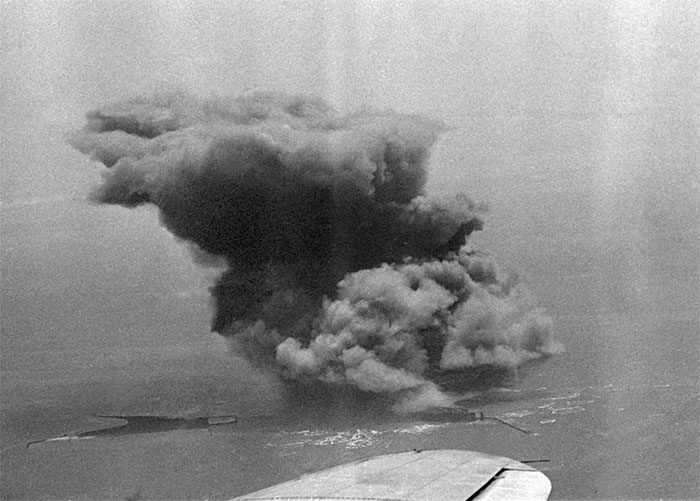After World War II, the UK occupied Heligoland, a territory of Germany located in the Baltic Sea.
At that time, the Nazi regime had established military facilities, and the British forces conducted operations to destroy them in a campaign known as “Big Bang.”
This operation caused a terrible explosion, the largest non-nuclear explosion ever conducted until 1985. It is also a lesser-known military campaign.
In an article for the American magazine National Geographic, British journalist Tom Metcalfe revealed details about the Big Bang campaign.
In this operation, the British military detonated thousands of tons of Nazi ordnance on Heligoland, off the coast of Germany.

The Big Bang campaign destroyed thousands of tons of ordnance on the island. (Photo: National Geographic).
The Great Non-Nuclear Explosion
The “Big Bang” campaign clearly demonstrated Britain’s ambition to destroy military facilities on the island. The German army had built a base system there during World War II, aiming to establish its dominance in the Baltic Sea.
This is considered a top-secret military operation of the UK, but leaked information led to public opposition, with scientists expressing concern that the explosion would alter the geology of Heligoland and could potentially destroy the island entirely.
Despite the opposition, the UK government decided to proceed with the operation. Nearly 7,000 tons of ordnance detonated simultaneously created a horrifying explosion.
Historian Jan Rüger from Birkbeck, University of London, explained: “The aim of the British was not to destroy the island but to eliminate the facilities of the German navy. This operation also symbolizes that Germany had lost the war and its military power was being eradicated.”
On April 18, 1947, the UK began the operation. The strength of the explosion was equivalent to 3.7 kilotons, only five times less powerful than the Fat Man nuclear bomb dropped by the United States on Nagasaki, Japan, in August 1945.
Fortunately, Heligoland did not disappear after the attack. Almost all buildings, including homes, were destroyed by the explosion. Today, only an anti-aircraft tower remains, the last remnant of the conflicts from World War II.
A German Stronghold in the Baltic Sea
The first traces of human occupation of Heligoland date back to the Medieval period when it was mined for ore. Later, the island was considered a strategic geographical area by the German military from the 1930s.
The German navy built a military port on the island to supply naval forces, submarines, and warships during the wars.
In 1952, the United Kingdom returned Heligoland to Germany. Today, over 1,000 people live on the island daily, and the area benefits from an economy based on fishing and tourism.
While the “Big Bang” campaign did not destroy the island, it profoundly altered the geology and topography, leaving a lasting imprint of the war.





















































